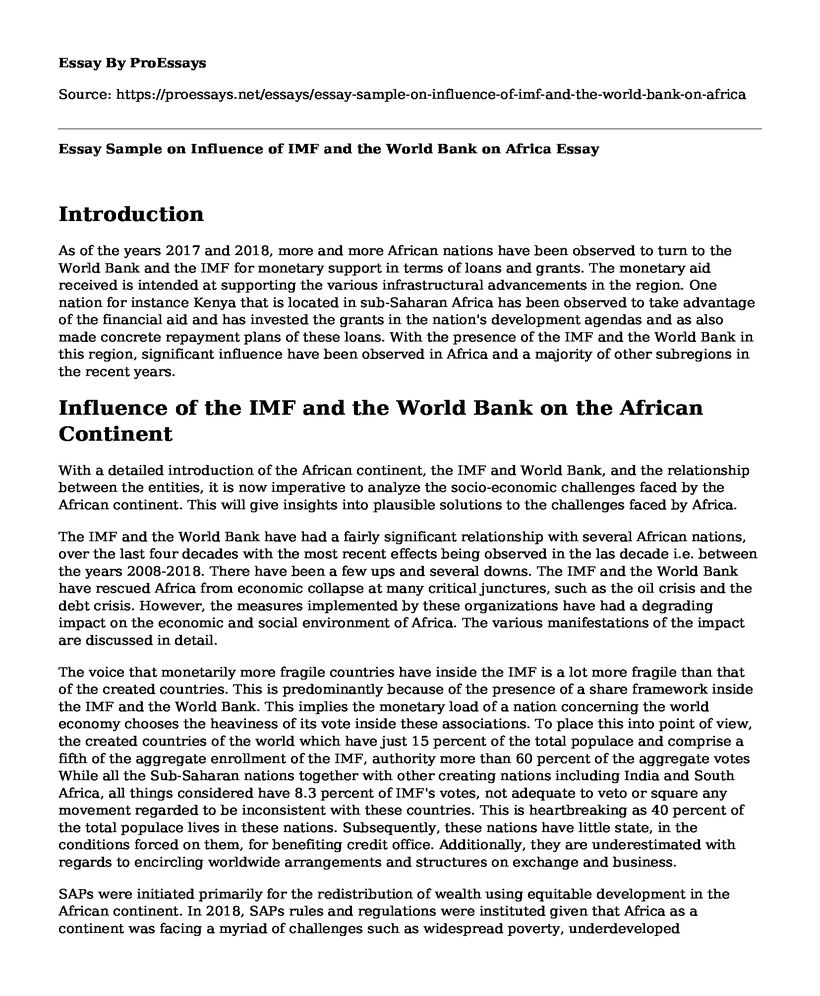Introduction
As of the years 2017 and 2018, more and more African nations have been observed to turn to the World Bank and the IMF for monetary support in terms of loans and grants. The monetary aid received is intended at supporting the various infrastructural advancements in the region. One nation for instance Kenya that is located in sub-Saharan Africa has been observed to take advantage of the financial aid and has invested the grants in the nation's development agendas and as also made concrete repayment plans of these loans. With the presence of the IMF and the World Bank in this region, significant influence have been observed in Africa and a majority of other subregions in the recent years.
Influence of the IMF and the World Bank on the African Continent
With a detailed introduction of the African continent, the IMF and World Bank, and the relationship between the entities, it is now imperative to analyze the socio-economic challenges faced by the African continent. This will give insights into plausible solutions to the challenges faced by Africa.
The IMF and the World Bank have had a fairly significant relationship with several African nations, over the last four decades with the most recent effects being observed in the las decade i.e. between the years 2008-2018. There have been a few ups and several downs. The IMF and the World Bank have rescued Africa from economic collapse at many critical junctures, such as the oil crisis and the debt crisis. However, the measures implemented by these organizations have had a degrading impact on the economic and social environment of Africa. The various manifestations of the impact are discussed in detail.
The voice that monetarily more fragile countries have inside the IMF is a lot more fragile than that of the created countries. This is predominantly because of the presence of a share framework inside the IMF and the World Bank. This implies the monetary load of a nation concerning the world economy chooses the heaviness of its vote inside these associations. To place this into point of view, the created countries of the world which have just 15 percent of the total populace and comprise a fifth of the aggregate enrollment of the IMF, authority more than 60 percent of the aggregate votes While all the Sub-Saharan nations together with other creating nations including India and South Africa, all things considered have 8.3 percent of IMF's votes, not adequate to veto or square any movement regarded to be inconsistent with these countries. This is heartbreaking as 40 percent of the total populace lives in these nations. Subsequently, these nations have little state, in the conditions forced on them, for benefiting credit office. Additionally, they are underestimated with regards to encircling worldwide arrangements and structures on exchange and business.
SAPs were initiated primarily for the redistribution of wealth using equitable development in the African continent. In 2018, SAPs rules and regulations were instituted given that Africa as a continent was facing a myriad of challenges such as widespread poverty, underdeveloped infrastructure, low life expectancy, low human development index, dependency on exports of a few commodities, etc. However, the 54 nations that make up Africa have their unique circumstances too. For providing effective solutions to their quandaries, it is imperative to delve deeper into the very fabric of these nations. However, SAPs implemented by the IMF and the World Bank are known to have a 'one size fits all' approach, where a readymade template is applied from one country to another. Development, a precondition for removing poverty, has not been fostered by the SAPs. Between 1982 and 1998, the IMF and the World Bank gave 10 or more structural adjustment loans to 36 nations, however, the growth rate of the median income level across these countries was zero.
SSA's i.e. Sub-Saharan Africa economy is assessed to have developed by 2.7 percent in 2017, from 1.4 percent in 2016, as ware costs solidified, budgetary markets stayed positive and abating swelling initiated family unit request. While the development recuperation in 2017 was joined by an enhancement in current record deficiencies, feature expansion, and financial shortfalls, the area's obligation markers kept on crumbling. Over the medium term, development in SSA is set to drive forward, achieving 3.3 percent in 2018 and 3.5 percent in 2019. The development standpoint for economies in Africa Group 1 Constituency in 2018 stays disparate, however comprehensively positive, as just six of the 22 nations are relied upon to develop beneath the SSA normal of 3.3 percent.
"Africa, the world's poorest region, pays the richest countries $15 billion every year in debt servicing. This is more than the continent gets in aid, new loans or investment" stat...
Cite this page
Essay Sample on Influence of IMF and the World Bank on Africa. (2022, Nov 03). Retrieved from https://proessays.net/essays/essay-sample-on-influence-of-imf-and-the-world-bank-on-africa
If you are the original author of this essay and no longer wish to have it published on the ProEssays website, please click below to request its removal:
- Essay Sample on Disparity in Wage and Ethnicity
- Paper Example on FMLA Act: Financial Pressure, Limited Eligibility, Inflexible Leave
- Essay on New Employee Onboardng: Enhancing Hilton's Program to Reduce Employee Turnover
- Argentina's FDI: Impact on Its Economic Growth - Essay Sample
- Essay on U.S. Judicial System: Ensuring People Obey Laws & Eliminating Conflicts
- NIH Employees Need a Union: Reasons Why - Essay Sample
- Paper Example on Chained & Mumbling: Mental Illness in West Africa







